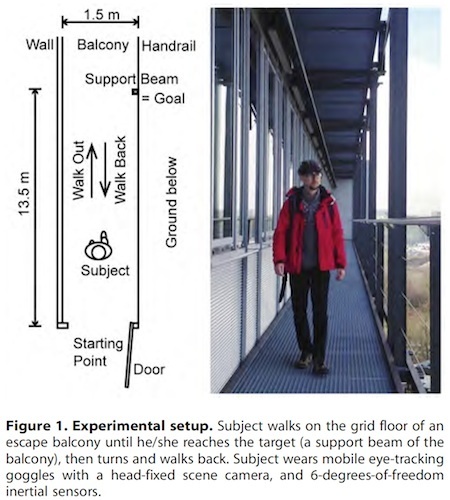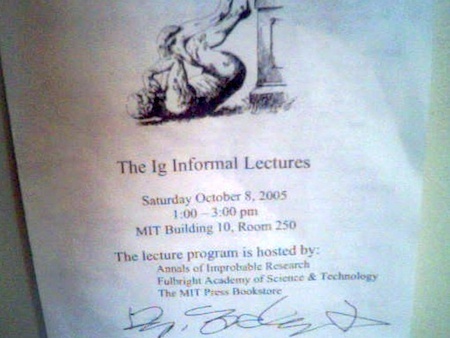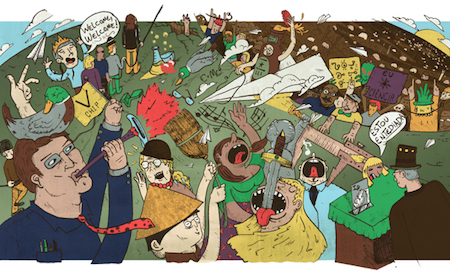Marc Abrahams's Blog, page 382
August 28, 2014
Hitchcockian Fear-of-Heights Gaze Research
In the tradition of film director Alfred Hitchcock, these researchers watched the way fearful people watched their surroundings whilst walking in fear:
 “Visual Exploration during Locomotion Limited by Fear of Heights,” Günter Kugler, Doreen Huppert, Maria Eckl, Erich Schneider, Thomas Brandt [pictured here], PLoS ONE, 9(8), 2014, e105906. The authors, at the University of Munich and Brandenburg University of Technology Cottbus – Senftenberg, report:
“Visual Exploration during Locomotion Limited by Fear of Heights,” Günter Kugler, Doreen Huppert, Maria Eckl, Erich Schneider, Thomas Brandt [pictured here], PLoS ONE, 9(8), 2014, e105906. The authors, at the University of Munich and Brandenburg University of Technology Cottbus – Senftenberg, report:
“Visual exploration of the surroundings during locomotion at heights has not yet been investigated in subjects suffering from fear of heights…. Eye and head movements were recorded separately in 16 subjects susceptible to fear of heights and in 16 non-susceptible controls while walking on an emergency escape balcony 20 meters above ground level…. During locomotion, anisotropy of gaze-in-space shows a preference for the vertical as opposed to the horizontal direction during stance. Avoiding looking into the abyss may reduce anxiety in both conditions; exploration of the ‘vertical strip’ in the heading direction is beneficial for visual control of balance and avoidance of obstacles during locomotion.”
This detail from the study shows the experimental setup:

BONUS: A clip from Hitchcock’s film “Vertigo”:

Tooth-clicking for better Internet browsing?
Tooth-clicking is in its infancy as a means of telling a computer what to do, and when to do it. The hope is that, in a symphony-of-body-parts approach, clicking your teeth will become one of the almost-natural ways you will interact with computing devices….
—so begins another Improbable Innovation nugget, which appears in its entirety on BetaBoston.

Sam the student’s view of the 2005 Ig Nobel ceremony
Back in 2005, a Massachusetts Institute of Technology student named Sam went to that year’s Ig Nobel Prize ceremony and then to the Ig Informal Lectures. Sam wrote up his impressions:
Last Thursday, I had the pleasure of attending the Ig Nobel awards ceremony in H****** Square. The “Igs,” sponsored by a bunch of Mensa nerds actual Nobel Laureates from both H****** and MIT, celebrate nontraditional research in a variety of disciplines. This year, awards were bestowed upon ten leading researchers from four different continents for answering some of the following questions:
1. Do people swim faster in water or in syrup?
2. What internal pressures are observed upon penguin defecation?
3. Are neutered pets somehow less happy than regular pets?
4. What about Star Wars Episode IV: A New Hope is most appealing to a common cricket?
5. How can we best improve our nation’s economy?
6. Why bother to photograph and retrospectively analyze every meal you’ve eaten over a period of 34 years?…
6. Why bother to photograph and retrospectively analyze every meal you’ve eaten over a period of 34 years?
Well, I’m not sure this one has a clear answer, really. Dr. Yoshiro Nakamats, winner of the Ig Nobel in Nutrition, delivered perhaps the most inspiring and concise acceptance speech at the Ig Nobel ceremony:
“Life is long … should be longer … speech … should be shorter … Good night.”
Or perhaps this profound, almost poetic summation of the human condition merely seemed to be a brief moment of clarity amidst an opera dedicated to counting to infinite, programs being folded into paper planes and thrown at the stage (sometimes during the speeches of actual Nobel Laureates) and 24/7 speeches on animal morphology, primate locomotion, the purpose of life. The lattermost of these consist of speeches of 24 seconds that convey “everything there is to know” about a topic and then 7 words that summarize it in a manner that is “understandable to everyone.” Anyway, all this commotion left me with quite a favorable impression of Dr. Nakamats.
Then some other people on my floor went to the free Ig Informal lectures and discovered some more about Dr. Nakamats, as well as getting the distinguished scientist to autograph their program for him….
Read Sam’s entire assessment, on the MIT Admissions Blog.
Dr. Nakamats will be returning this year, to give the keynote address at the 2014 Ig Nobel Prize Ceremony on September 18, and then to do a brief talk at the Ig Informal Lectures on September 20.
(We do not know what Sam is doing these days, or where he is doing it.)
Here’s video of the entire 2005 Ig Nobel ceremony. Dr. Nakamats is awarded his prize at about the 1:08:40 mark:

How to begin a scientific paper: “Gears are found rarely in animals…”
This research paper, published in the journal Science, demonstrates that yes, it is possible to begin a scientific paper with a colorful thought. The very first sentence begins with these words:
“Gears are found rarely in animals…”

August 27, 2014
Dishonesty and creativity can spur each other, says study
A little dishonesty can, maybe, in the right hands, used judiciously, be a tool that brings creativity to your business, suggests a study by Professor Francesca Gino of Harvard Business School and Scott S. Wiltermuth of the University of Southern California’s Marshall School of Business.
(The video you see here shows Duke University [and former MIT] professor Dan Ariely, who has conducted much related research with Gino. One of their joint papers is a corker called “The dark side of creativity: original thinkers can be more dishonest.” In this video, Ariely pokes into the happy troika of lies, cheating, and creativity.)
Gino and Wiltermuth did some little experiments…
—so begins another Improbable Innovation nugget, which appears in its entirety on BetaBoston.

Crying Infant Assuager (new patent)
“Crying babies are the source of great frustration for adults, particularly for their parents. Because they cannot speak, infants cry as their primary means of communication and they do it with great frequency. Babies cry as a means to communicate that they are in pain, unhappy, tired, hungry or generally in need of attention. Sometimes babies cry to block external stimuli in an attempt to calm down. Regardless of the reason, crying is disturbing and gets the attention of those within earshot.”
explain Californian inventors Richard Shane and Chris Tacklind in their newly issued patent Infant Soothing Device Having an Actuator, which is, in a nutshell:
“A device to assuage distressed infants via an adjustable vertical motion combined with an adjustable orientation.”
[...]
“In an embodiment of the invention, the device utilizes springs to assist the motion generated by the motor, thereby reducing the power requirements of the motor. In other embodiments of the invention, different types of devices are used to enable the motion of the invention, such as air bellows, pneumatic pumps, hydraulic or magnetic devices and the like.”
Also see: (somewhat related) ‘I was not a lab rat’ by Deborah Skinner Buzan (daughter of Burrhus Frederic Skinner)
“Call it what you will, the ‘aircrib’ ,’baby box’, ‘heir conditioner’ (not my father’s term) was a wonderful alternative to the cage-like cot.”

August 26, 2014
Urination, free will, and the John Templeton Foundation
What kind of research is funded by the John Templeton Foundation, you might ask. This kind:
“Embodied free will beliefs: Some effects of physical states on metaphysical opinions,” Michael R. Ent, Roy F. Baumeister, Consciousness and Cognition, vol. 27, July 2014, pp. 147–154. The authors write:
The present research suggests that… The more intensely people felt… the urge to urinate, the less they believed in free will….
This work was supported by the John Templeton Foundation.

If your theory abut hurricane names stirs up a tempest, then…
Here’s the newest effusion from the hurricane-names authors whose paper stirred up a tempest:
“Reply to Christensen and Christensen and to Malter: Pitfalls of erroneous analyses of hurricanes names,” Proceedings of the National Academy of Sciences, vol. 111 no. 34, 2014, E3499–E3500. They write:
“We are grateful for this opportunity to provide additional support for our conclusions about the role of name femininity in responses to storms.”
BONUS (possibly related, form 2005): Ig Nobel and Hurricane Katrina

Daniel Chastinet’s cornucopiac Ig Nobel drawings
Brazilian artist Daniel Chastinet shows off, on the web, some of the drawings he did for a a Revista Super Interessante article, in 2013, about the “backstage” aspects of the Ig Nobel Prizes. Here’s one of those drawings, which packs in a remarkable number of aspects of the Ig Nobel ceremony and some of the winners:

A medical study the entire family can enjoy
This is a medical study the entire family can enjoy, one way and another:
“Effect of maternal coffee, smoking and drinking behavior on adult son’s semen quality,” P.M. Cirillo, B.A. Cohn, N.Y. Krigbaum, M. Lee, C. Brazil, and Pam Factor-Litvak [pictured here], Journal of Developmental Origins of Health and Disease, vol. 2, no. 6, 2011, pp. 375-386.
The authors are at the Public Health Institute, Berkeley, CA, the University of California, Davis, and Columbia University, New York.

Marc Abrahams's Blog
- Marc Abrahams's profile
- 14 followers






